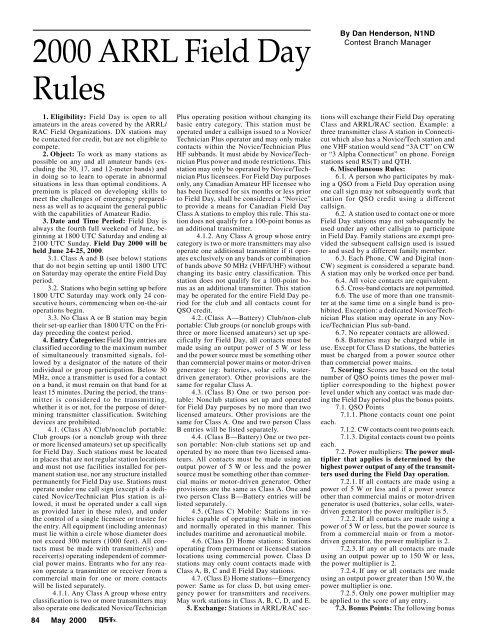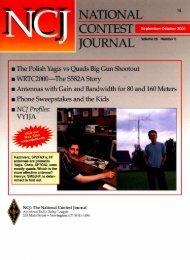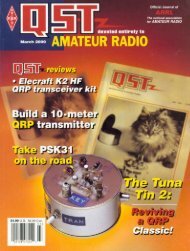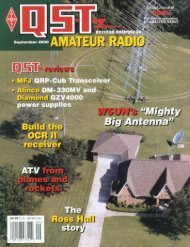<strong>2000</strong> ARRL Field DayRulesBy Dan Henderson, N1NDContest Branch Manager1. Eligibility: Field Day is open to allamateurs in the areas covered by the ARRL/RAC Field Organizations. DX stations maybe contacted for credit, but are not eligible tocompete.2. Object: To work as many stations aspossible on any and all amateur bands (excludingthe 30, 17, and 12-meter bands) andin doing so to learn to operate in abnormalsituations in less than optimal conditions. Apremium is placed on developing skills tomeet the challenges of emergency preparednessas well as to acquaint the general publicwith the capabilities of Amateur Radio.3. Date and Time Period: Field Day isalways the fourth full weekend of June, beginningat 1800 UTC Saturday and ending at2100 UTC Sunday. Field Day <strong>2000</strong> will beheld June 24-25, <strong>2000</strong>.3.1. Class A and B (see below) stationsthat do not begin setting up until 1800 UTCon Saturday may operate the entire Field Dayperiod.3.2. Stations who begin setting up before1800 UTC Saturday may work only 24 consecutivehours, commencing when on-the-airoperations begin.3.3. No Class A or B station may begintheir set-up earlier than 1800 UTC on the Fridaypreceding the contest period.4. Entry Categories: Field Day entries areclassified according to the maximum numberof simultaneously transmitted signals, followedby a designator of the nature of theirindividual or group participation. Below 30MHz, once a transmitter is used for a contacton a band, it must remain on that band for atleast 15 minutes. During the period, the transmitteris considered to be transmitting,whether it is or not, for the purpose of determiningtransmitter classification. Switchingdevices are prohibited.4.1. (Class A) Club/nonclub portable:Club groups (or a nonclub group with threeor more licensed amateurs) set up specificallyfor Field Day. Such stations must be locatedin places that are not regular station locationsand must not use facilities installed for permanentstation use, nor any structure installedpermanently for Field Day use. Stations mustoperate under one call sign (except if a dedicatedNovice/Technician Plus station is allowed,it must be operated under a call signas provided later in these rules), and underthe control of a single licensee or trustee forthe entry. All equipment (including antennas)must lie within a circle whose diameter doesnot exceed 300 meters (1000 feet). All contactsmust be made with transmitter(s) andreceiver(s) operating independent of commercialpower mains. Entrants who for any reasonoperate a transmitter or receiver from acommercial main for one or more contactswill be listed separately.4.1.1. Any Class A group whose entryclassification is two or more transmitters mayalso operate one dedicated Novice/Technician84 <strong>May</strong> <strong>2000</strong>Plus operating position without changing itsbasic entry category. This station must beoperated under a callsign issued to a Novice/Technician Plus operator and may only makecontacts within the Novice/Technician PlusHF subbands. It must abide by Novice/TechnicianPlus power and mode restrictions. Thisstation may only be operated by Novice/TechnicianPlus licensees. For Field Day purposesonly, any Canadian Amateur HF licensee whohas been licensed for six months or less priorto Field Day, shall be considered a “Novice”to provide a means for Canadian Field DayClass A stations to employ this rule. This stationdoes not qualify for a 100-point bonus asan additional transmitter.4.1.2. Any Class A group whose entrycategory is two or more transmitters may alsooperate one additional transmitter if it operatesexclusively on any bands or combinationof bands above 50 MHz (VHF/UHF) withoutchanging its basic entry classification. Thisstation does not qualify for a 100-point bonusas an additional transmitter. This stationmay be operated for the entire Field Day periodfor the club and all contacts count forQSO credit.4.2. (Class A—Battery) Club/non-clubportable: Club groups (or nonclub groups withthree or more licensed amateurs) set up specificallyfor Field Day, all contacts must bemade using an output power of 5 W or lessand the power source must be something otherthan commercial power mains or motor-drivengenerator (eg: batteries, solar cells, waterdrivengenerator). Other provisions are thesame for regular Class A.4.3. (Class B) One or two person portable:Nonclub stations set up and operatedfor Field Day purposes by no more than twolicensed amateurs. Other provisions are thesame for Class A. One and two person ClassB entries will be listed separately.4.4. (Class B—Battery) One or two personportable: Non-club stations set up andoperated by no more than two licensed amateurs.All contacts must be made using anoutput power of 5 W or less and the powersource must be something other than commercialmains or motor-driven generator. Otherprovisions are the same as Class A. One andtwo person Class B—Battery entries will belisted separately.4.5. (Class C) Mobile: Stations in vehiclescapable of operating while in motionand normally operated in this manner. Thisincludes maritime and aeronautical mobile.4.6. (Class D) Home stations: Stationsoperating from permanent or licensed stationlocations using commercial power. Class Dstations may only count contacts made withClass A, B, C and E Field Day stations.4.7. (Class E) Home stations—Emergencypower: Same as for class D, but using emergencypower for transmitters and receivers.<strong>May</strong> work stations in Class A, B, C, D, and E.5. Exchange: Stations in ARRL/RAC sectionswill exchange their Field Day operatingClass and ARRL/RAC section. Example: athree transmitter class A station in Connecticutwhich also has a Novice/Tech station andone VHF station would send “3A CT” on CWor “3 Alpha Connecticut” on phone. Foreignstations send RS(T) and QTH.6. Miscellaneous Rules:6.1. A person who participates by makinga QSO from a Field Day operation usingone call sign may not subsequently work thatstation for QSO credit using a differentcallsign.6.2. A station used to contact one or moreField Day stations may not subsequently beused under any other callsign to participatein Field Day. Family stations are exempt providedthe subsequent callsign used is issuedto and used by a different family member.6.3. Each Phone, CW and Digital (non-CW) segment is considered a separate band.A station may only be worked once per band.6.4. All voice contacts are equivalent.6.5. Cross-band contacts are not permitted.6.6. The use of more than one transmitterat the same time on a single band is prohibited.Exception: a dedicated Novice/TechnicianPlus station may operate in any Novice/TechnicianPlus sub-band.6.7. No repeater contacts are allowed.6.8. Batteries may be charged while inuse. Except for Class D stations, the batteriesmust be charged from a power source otherthan commercial power mains.7. Scoring: Scores are based on the totalnumber of QSO points times the power multipliercorresponding to the highest powerlevel under which any contact was made duringthe Field Day period plus the bonus points.7.1. QSO Points7.1.1. Phone contacts count one pointeach.7.1.2. CW contacts count two points each.7.1.3. Digital contacts count two pointseach.7.2. Power multipliers: The power multiplierthat applies is determined by thehighest power output of any of the transmittersused during the Field Day operation.7.2.1. If all contacts are made using apower of 5 W or less and if a power sourceother than commercial mains or motor-drivengenerator is used (batteries, solar cells, waterdrivengenerator) the power multiplier is 5.7.2.2. If all contacts are made using apower of 5 W or less, but the power source isfrom a commercial main or from a motordrivengenerator, the power multiplier is 2.7.2.3. If any or all contacts are madeusing an output power up to 150 W or less,the power multiplier is 2.7.2.4. If any or all contacts are madeusing an output power greater than 150 W, thepower multiplier is one.7.2.5. Only one power multiplier maybe applied to the score of any entry.7.3. Bonus Points: The following bonus
W1AW Field Day Bulletin ScheduleLocal TimesMode Pacific Mountain Central EasternFriday CW 5:00 PM 6:00 PM 7:00 PM 8:00 PMTeleprinter 6:00 PM 7:00 PM 8:00 PM 9:00 PMPhone 6:45 PM 7:45 PM 8:45 PM 9:45 PMCW 8:00 PM 9:00 PM 10:00 PM 11:00 PMSaturday CW 7:00 AM 8:00 AM 9:00 AM 10:00 AMPhone 8:00 AM 9:00 AM 10:00 AM 11:00 AMCW 5:00 PM 6:00 PM 7:00 PM 8:00 PMTeleprinter 6:00 PM 7:00 PM 8:00 PM 9:00 PMPhone 6:45 PM 7:45 PM 8:45 PM 9:45 PMSunday CW 7:00 AM 8:00 AM 9:00 AM 10:00 AMPhone 8:00 AM 9:00 AM 10:00 AM 11:00 AMField Day Pins!It’s easy to earn an ARRL Field Day <strong>2000</strong>pin. There are no minimum number of contactsto make, no score levels to achieve. Allyou have to do is participate in the most popularannual operating event in the US andCanada. The pins are $5 each. Send yourorder to: ARRL Contest Branch, Attn. FieldDay Pins, 225 Main St, Newington, CT 06111.Field Day groups should collect themoney for the pins and send a single orderstating the number of pins needed. We willship the pins back to the club for distribution.These attractive pins are sure to becomepopular items. Show your Field Day spirit by displaying the Field Day participation pin! We soldout of pins in 1999. Order your FD <strong>2000</strong> pins early.points will be added to the score, after themultiplier is applied, to determine the finalField Day score. Only Class A and B stationsare eligible for bonus points. Bonus pointswill only be applied if the claim is made onthe summary sheet and any proof required isenclosed with the entry.7.3.1. 100% Emergency Power: 100points per transmitter classification if all contactsare made only using an emergency powersource. Free transmitters that do not counttowards the group’s total do not qualify forbonus point credit. All transmitting equipmentat the site must operate from a power sourcecompletely independent of the commercialpower mains to qualify. (Example: a club operating3 transmitters plus a Novice stationand using 100% emergency power receives300 bonus points.)7.3.2. Media Publicity: 100 bonuspoints may be earned for attempting to obtainpublicity from the local media. A copy ofthe press release, or a copy of the actual mediapublicity received (newspaper article, etc)must be submitted to claim the points.7.3.3. 100 bonus points for physicallylocating the Field Day operation in a publicplace (shopping center, community park,school campus). The intent is for AmateurRadio to be on display to the public.7.3.4. 100 bonus points for a publicinformation table at the Field Day site. Thepurpose is to make appropriate handouts andinformation available to the visiting public atthe site. Visitor logs, photos or copies of clubhandouts are sufficient evidence for claimingthis bonus.7.3.5. Message Origination: 100 bonuspoints for origination of a National TrafficSystem (NTS) style formal message to theARRL Section Manager or Section EmergencyCoordinator by your group from its site.You should include the club name, number ofparticipants, Field Day location, and numberof ARES operators involved with your station.The message must be transmitted during theField Day period and a fully serviced copy ofit must be included in your submission, instandard ARRL NTS format, or no credit willbe given.7.3.6. Message Relay: 10 points foreach formal NTS style received and relayedduring the Field Day period, up to a maximumof 100 points total. Properly servicedcopies of each message must be included withthe Field Day report.7.3.7. Satellite QSO: 100 bonus pointsfor successfully completing at least one QSOvia an amateur radio satellite during the FieldDay period. Under the “General Rules for AllARRL Contests” (rule 3.7.2.), the no-repeaterQSO stipulation is waived for satellite QSOs.Groups are allowed one dedicated satellitetransmitter station without increasing their entrycategory. Satellite QSOs also count forregular QSO credit. Show them listed separatelyon the summary sheet as a separate“band.”7.3.8. 100 bonus points for Field Daygroups making a minimum of five QSOswithout using power from commercialmains or a petroleum driven generator. Thismeans an “alternate” energy source of power,such as solar, wind, methane or water. Thisincludes batteries charged by natural means(not dry cells). The natural power transmittercounts as an additional transmitter. If you donot wish to it to increase your operating category,you should take one of your other transmittersoff the air while the natural powertransmitter is in operation. A separate list ofnatural power QSOs should be submitted withyour entry.7.3.9. 100 bonus points for copyingthe special Field Day bulletin transmittedby W1AW during its operating scheduleduring the Field Day weekend (listed in thisrules announcement). An accurate copy ofthe message is required to be included in yourField Day submission. (Note: The Field Daybulletin must be copied via Amateur Radio.It will not be included in Internet bulletinssent from Headquarters and will notbe posted to Internet BBS sites.)7.3.10. 100 bonus points for settingup a demonstration of a nontraditionalmode of Amateur Radio communications.This includes modes such as APRS, ATV,and SSTV. This bonus is not available fordemonstration of a mode for which regularQSO credit is available (such as packet,PSK31, or other digital modes.)8. Reporting:8.1. Entries must be postmarked oremailed by July 24, <strong>2000</strong>. No late entries canbe accepted. A complete entry consists of:8.1.1. An official ARRL summarysheet (or reasonable facsimile) which is completelyand accurately filled out;8.1.2. A list of stations worked byband/mode during the Field Day period (dupesheet or an alpha/numeric list sorted by bandand mode);8.1.3. Proofs of bonus points claimed.8.2. Complete station logs are not requiredfor submission. However, log filesshould be kept in case ARRL HQ requeststhem.8.3. Electronic submissions should be e-mailed to: FieldDay@arrl.org and shouldinclude, as attachments to the e-mail, the requiredsummary sheet and dupe files as wellas document files and/or image files to supportany bonus points claimed.8.4. Paper submissions should be mailedto: Field Day Entry, ARRL, 225 Main St,Newington, CT 061119. Miscellaneous:9.1. The list of bulletin times for W1AWis included in this announcement. WhileW1AW does not have regular bulletins onweekends, the Field Day message will be sentaccording to the schedule included with thisannouncement.9.2. See “General Rules for All ARRLContests,” “General Rules for All ARRL Contestson Bands Below 30 MHz,” and “GeneralRules for All ARRL Contests on BandsAbove 50 MHz” (November 1999 issue of<strong>QST</strong>) for additional rules.9.3. The national simplex FM callingfrequency of 146.52 MHz cannot be usedfor making Field Day contacts.9.4. The complete Field Day informationpackage may be obtained by:9.4.1. Sending a SASE with 3 units ofpostage to: Field Day Information Package,ARRL, 225 Main St, Newington, CT 06111;9.4.2. By downloading from the ContestBranch home page at: http://www.arrl.org/contests/forms.9.5. For additional Field Day informationor questions contact: n1nd@arrl.org orphone 860-594-0232.<strong>May</strong> <strong>2000</strong> 85
- Page 6 and 7:
May 2000 Volume 84 Number 5David S
- Page 11 and 12:
THE AMERICAN RADIORELAY LEAGUE INC
- Page 14:
Get to Know Your Section ManagerThe
- Page 18:
The ARRL and the FCC’s Private Wi
- Page 22 and 23:
The postman always keys twice.Accor
- Page 26 and 27:
CORRESPONDENCEYour opinions count!
- Page 30 and 31:
By Ian Poole, G3YWXOperating in the
- Page 32 and 33:
By Roger Sullivan, WA0ETE, and Hugh
- Page 34 and 35:
By Jim Graver, KB8PSO2000Dayton Ham
- Page 36 and 37: Figure 1A—Schematic of the interf
- Page 38 and 39: All input/output connections are ma
- Page 40 and 41: Figure 4—Hanger loopconstruction.
- Page 42 and 43: Figure 2—A GOES-8 picture capture
- Page 44 and 45: By Steve Ford, WB8IMYPSK31 2000In e
- Page 46 and 47: the software, PSK31 tuning required
- Page 48 and 49: WORKBENCHPROJECTS AND INFORMATION F
- Page 50 and 51: By Martin A. Minow, K6MAMPractice M
- Page 52 and 53: the download to a suitable location
- Page 54 and 55: 52 May 2000SHORT TAKESHeil Sound Go
- Page 56 and 57: By Zack Lau, W1VTA No-Tune 2-Meter
- Page 58 and 59: HINTS & KINKSA FOLD-DOWN MOBILE-ANT
- Page 60 and 61: By James Kates, N9GBBConfessions of
- Page 62 and 63: PRODUCT REVIEWKenwood TM-D700A Dual
- Page 64 and 65: is accomplished by using OK, BACK a
- Page 66 and 67: other radio operation. The chatter
- Page 68 and 69: operation because there’s so litt
- Page 70 and 71: consideration in the WT Docket 98-1
- Page 72 and 73: News in Brief:• League members no
- Page 74 and 75: communications tests in celebration
- Page 76 and 77: I’ve done this tour several years
- Page 78 and 79: The Crystal Symphony at anchor off
- Page 80 and 81: Table 1Claimed North American Dista
- Page 82 and 83: Okay in My LogBy Vic Curtis,WA3YUVP
- Page 84 and 85: their 432 MHz triumph of the previo
- Page 88 and 89: Collecting Vintage QSLsOLD RADIOAn
- Page 90 and 91: DIGITAL DIMENSIONAPRS Digipeater in
- Page 92 and 93: AT THE FOUNDATIONWhy We Fund Museum
- Page 94 and 95: It is with deep regret that we reco
- Page 96 and 97: COMING CONVENTIONSARRL NATIONAL CON
- Page 98 and 99: checking; handicapped accessible; f
- Page 106: of the West Allis ARC and served as
- Page 110: introduced that could of had a bear
- Page 114: 211/109; NJN/L 29/203/103; CJTN 29/
- Page 118: W1PEX 1048, WA1JVV 143, N1NH 105, W
- Page 124: an activity we enjoy so much can be
- Page 128: 126He is President of the Amateur R
- Page 132: is Walt Bacon, N6SMT, who is curren
- Page 150:
Ham Adsl) Advertising must pertain
- Page 154:
BAHAMAS RENTAL: Abaco villa w/stati
- Page 164:
“EVERYTHING FOR THE MORSE ENTHUSI
- Page 168:
TUBES WANTED: Highest prices paid o
















